Related Research Articles

The Croats are a South Slavic ethnic group native to Croatia, Bosnia and Herzegovina and other neighboring countries in Central and Southeastern Europe who share a common Croatian ancestry, culture, history and language. They also form a sizeable minority in a number of neighboring countries, namely Slovenia, Austria, the Czech Republic, Germany, Hungary, Italy, Montenegro, Romania, Serbia and Slovakia.

The Kingdom of Croatia entered a personal union with the Kingdom of Hungary in 1102, after a period of rule of kings from the Trpimirović and Svetoslavić dynasties and a succession crisis following the death of king Demetrius Zvonimir. With the coronation of King Coloman of Hungary as "King of Croatia and Dalmatia" in 1102 in Biograd, the realm passed to the Árpád dynasty until 1301, when the (male) line of the dynasty died out. Then, kings from the Capetian House of Anjou, who were also cognatic descendants of the Árpád kings, ruled the kingdoms. Later centuries were characterized by conflicts with the Mongols, who sacked Zagreb in 1242, competition with Venice for control over Dalmatian coastal cities, and internal warfare among Croatian nobility. Various individuals emerged during the period, such as Paul I Šubić of Bribir, who was representing the most powerful Croatian dynasty at the time, the Šubić noble family. These powerful individuals were on occasion able to de facto secure great deal of independence for their fiefdoms. The Ottoman incursion into Europe in the 16th century significantly reduced Croatian territories and left the country weak and divided. After the death of Louis II in 1526 during the Battle of Mohács and a brief period of dynastic dispute, both crowns passed to the Austrian House of Habsburg, and the realms became part of the Habsburg monarchy.

Solin is a town and a suburb of Split, in Split-Dalmatia county, Croatia. It is situated right northeast of Split, on the Adriatic Sea and the river Jadro.

Tomislav was the first king of Croatia. He became Duke of Croatia c. 910 and was crowned king in 925, reigning until 928. During Tomislav's rule, Croatia forged an alliance with the Byzantine Empire against Bulgaria. Croatia's struggles with the First Bulgarian Empire eventually led to war, which culminated in the decisive Battle of the Bosnian Highlands in 926. In the north, Croatia often clashed with the Principality of Hungary; the state retained its borders and, to some extent, expanded with the disintegrated Lower Pannonia.

The Uskoks were irregular soldiers in Habsburg Croatia that inhabited areas on the eastern Adriatic coast and surrounding territories during the Ottoman wars in Europe. Bands of Uskoks fought a guerrilla war against the Ottomans, and they formed small units and rowed swift boats. Since the uskoks were checked on land and were rarely paid their annual subsidy, they resorted to acts of piracy.

The Trpimirović dynasty was a native Croatian dynasty that ruled in the Duchy and later the Kingdom of Croatia, with interruptions by the Domagojević dynasty from 845 until 1091. It was named after Trpimir I, the first member and founder. The most prominent rulers of the Trpimirović Dynasty include Tomislav, Petar Krešimir IV and Demetrius Zvonimir. The house gave four dukes, thirteen kings and a queen.
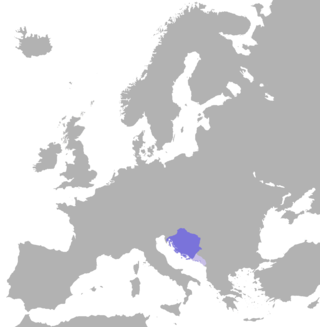
The Kingdom of Croatia, or Croatian Kingdom, was a medieval kingdom in Southern Europe comprising most of what is today Croatia, as well as most of the modern-day Bosnia and Herzegovina. The Croatian Kingdom was ruled for part of its existence by ethnic dynasties, and the Kingdom existed as a sovereign state for nearly two centuries. Its existence was characterized by various conflicts and periods of peace or alliance with the Bulgarians, Byzantines, Hungarians, and competition with Venice for control over the eastern Adriatic coast. The goal of promoting the Croatian language in the religious service was initially introduced by the 10th century bishop Gregory of Nin, which resulted in a conflict with the Pope, later to be put down by him. In the second half of the 11th century Croatia managed to secure most coastal cities of Dalmatia with the collapse of Byzantine control over them. During this time the kingdom reached its peak under the rule of kings Peter Krešimir IV (1058–1074) and Demetrius Zvonimir (1075–1089).
The History of Dalmatia concerns the history of the area that covers eastern coast of the Adriatic Sea and its inland regions, from the 2nd century BC up to the present day. The region was populated by Illyrian tribes around 1,000 B.C, including the Delmatae, who formed a kingdom and for whom the province is named. Later it was conquered by Rome, thus becoming the province of Dalmatia, part of the Roman Empire. Dalmatia was ravaged by barbaric tribes in the beginning of the 4th century.
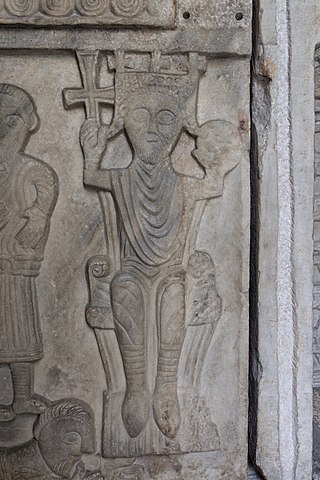
Demetrius Zvonimir was a King of Croatia and Dalmatia from 1075 or 1076 until his death in 1089. Zvonimir also served as Ban of Croatia (1064/1070–1074), and was named Duke of Croatia in around 1075. His native name was Zvonimir, but adopted the forename Demetrius at his coronation.
Branimir was a ruler of the Duchy of Croatia who reigned as duke from 879 to c. 892. His country received papal recognition as a state from Pope John VIII on 7 June 879. During his reign, Croatia retained its sovereignty from both Carolingian and Byzantine rule and became de jure independent. His rule marks the first real peak of early medieval Croatia. It was characterized by establishing closer relations with the Holy See, ecclestical re-organization in the former Roman province of Dalmatia, Christianization, and (re)construction of churches. Branimir is mentioned, for the period, in many reliable primary and secondary written and epigraphic sources.

Muncimir, sometimes called Mutimir, was a duke of the Duchy of Croatia and reigned from 892 to around 910. He was a member of the House of Trpimirović.
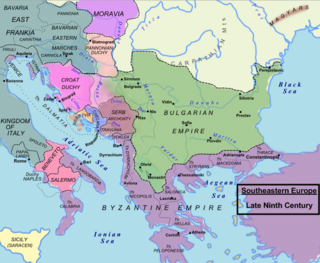
Domagoj was Duke of Croatia from 864 to 876, and the founder of the Domagojević dynasty. He usurped the Croatian throne after the death of Trpimir I and expelled his sons. He took a more active role in the Adriatic Sea than his predecessors, encouraged the use of force and waged many wars, specifically with the Arabs, Venice and the East Francia. Domagoj's belligerence and the tolerance and support of piracy caused bad relations with Pope John VIII, which was further worsened after Domagoj showed no mercy to his conspirators. Formally a Frankish vassal, he used to his advantage the Frankish succession crisis and started a successful revolt against Carloman of Bavaria. After his death in 876, Domagoj was succeeded by his son who was deposed and expelled by Zdeslav in 878.

Frane Bulić was a Croatian priest, archaeologist, and historian.

The Klis Fortress is a medieval fortress situated above the village of Klis, near Split, Croatia. From its origin as a small stronghold built by the ancient Illyrian tribe Dalmatae, to a role as royal castle and seat of many Croatian kings, to its final development as a large fortress during the Ottoman wars in Europe, Klis Fortress has guarded the frontier, being lost and re-conquered several times throughout its 2,000-year history. Due to its location on a pass that separates the mountains Mosor and Kozjak, the fortress served as a major source of defense in Dalmatia, especially against the Ottoman Empire. It has been a crossroad between the Mediterranean Sea and the Balkans.

Trpimir I was a duke in Croatia from around 845 until his death in 864. He is considered the founder of the Trpimirović dynasty that ruled in Croatia, with interruptions, from around 845 until 1091. Although he was formally vassal of the Frankish Emperor Lothair I, Trpimir used Frankish-Byzantine conflicts to rule on his own.

The Duchy of Croatia was a medieval state that was established by White Croats who migrated into the area of the former Roman province of Dalmatia c. 7th century AD. Throughout its existence the Duchy had several seats – namely, Klis, Solin, Knin, Bijaći and Nin. It comprised the littoral – the coastal part of today's Croatia – except Istria, and included a large part of the mountainous hinterland as well. The Duchy was in the center of competition between the Carolingian Empire and the Byzantine Empire for rule over the area. Croatian rivalry with Venice emerged in the first decades of the 9th century and would continue through the following centuries. Croatia also waged battles with the Bulgarian Empire and with the Arabs; it also sought to extend its control over important coastal cities under the rule of Byzantium. Croatia experienced periods of vassalage to the Franks or to the Byzantines and of de facto independence until 879, when Duke Branimir was recognized as an independent ruler by Pope John VIII. The Duchy was ruled by the Trpimirović and Domagojević dynasties from 845 to 1091. Around 925, during the rule of Tomislav, Croatia became a kingdom.
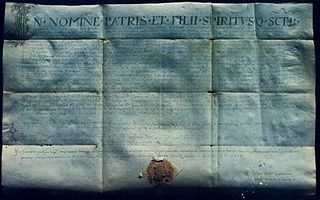
Charter of Duke Trpimir, also known as Trpimir's deed of donation is the oldest preserved document of the Croatian law, the oldest from the court of one of the Croatian rulers and the first national document which mentions the Croatian name. Charter, dated to 4 March 852, is not preserved in its original form but in five subsequent transcripts out of which the oldest is from year 1568.
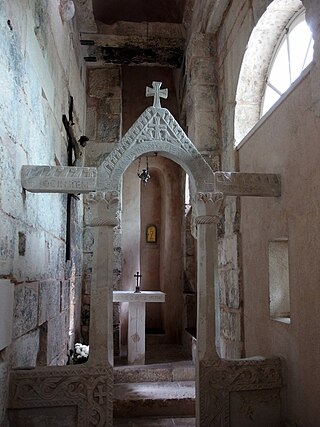
St. Martin's Church is a Roman Catholic church in Split, Croatia. Built into a small space within the ancient Golden Gate of Diocletian's northern wall, it is one of the oldest churches in the city. St. Martin's Church is one of Split's tourist attractions and is known for its fine 11th century chancel screen. It is currently in the care of the Dominican sisters, who have a monastery next door. The church itself is open to public visits.
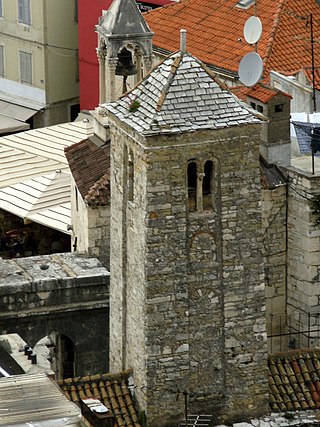
The Belltower of the Church of Our Lady of the Belfry is a disused Roman Catholic church in Split, Croatia. Built into a small space within the ancient Iron Gate of Diocletian's western wall. Today little survives of the building, apart from the belltower, one of the oldest in Croatia.
References
- 1 2 Mladjov, Ian. "Croatian Rulers" (PDF). Archived from the original (PDF) on 2016-03-03. Retrieved 2011-05-21.
- 1 2 3 4 "Mislav". Croatian Encyclopedia (in Croatian). Retrieved 2016-07-08.
- ↑ "Hrvatski opći leksikon: A-Ž". Hrvatski Opći Leksikon (in Croatian). Zagreb: Miroslav Krleža Lexicographical Institute. 1996. ISBN 953-6036-62-2.[ full citation needed ]
- ↑ Norwich, John Julius. A History of Venice. Alfred A. Knopf: New York, 1982.
- ↑ Josipović, Ivan (2018). "Tri nova posvetna natpisa s imenima hrvatskih vladara iz karolinškog perioda" [Three New Votive Inscriptions With the Names of Croatian Rulers from the Carolingian Period]. Starohrvatska Prosvjeta. III (44–45): 137–151. Retrieved 24 January 2023.